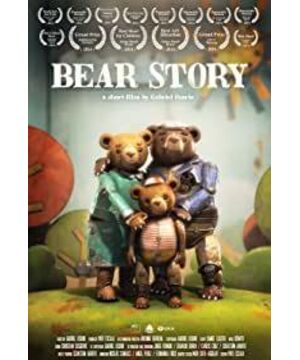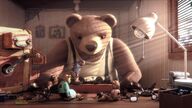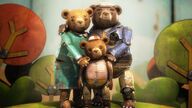The beginning of this short film starts with the props of the Xiong family in the foreign painting box. That in itself means a lot. The camera returns to the real world, and it turns out that a big bear is making these delicate props. We can see pictures of the bear family hanging, but not his family. What is the reason? This in itself leaves a suspense for the audience.
Carrying his suitcase, Xiong looked back at the photos of his relatives and left the house. He came to the street to ring the bell, and a little bear was attracted. At this time, the main topic of the story began dreamily in the form of a doll prop in a foreign painting box.
In the story of the foreign painting box, the fact that Xiong originally had a happy family does not need to be said, but in response to some audience's understanding of the circus part, I have to say that the circus that appears here is not a real circus, but It is a metaphor for other things in the world. If you want to ask the reason, first of all, there are a group of people in red police uniforms. There is no such person in the circus, so this has obvious political implications. Second, there is no need to use animals as the focus of the circus in the animal world. But these two logical reasons are secondary. Like many books and works of art, this needs to be felt more intuitively. If you can't comprehend it with your feelings at first glance, it really means that you don't have a good understanding of the author's intentions.
So what does this circus symbolize? The answer is: oppression in all societies and in life. Oppressing people to leave their warm homes and loved ones to foster illicit will, forcing people to pay cheap labor to meet the needs of another machine to run. This kind of oppression may be political, it may be economic, it may be religious, it may be people, it may be institutions, it may be institutions, it doesn’t have to be anything, but it always exists. Therefore, no matter in any era or in any place, people can always find its prototype according to their own life experience and situation, and everyone can experience it for themselves, so there is no need to explain it too much here.
Then, the bear's experience of suffering in the circus after being caught is actually the hardship and hardship after being trapped in this kind of oppression. The focus here is on homes. It's the city that was drifting away when the bear was caught. This shot means that we are forced to leave that warm home in our hearts. For this point, I think that no matter what country you are in, people who set foot on the reality will have some feelings.
After that, in the process of being whipped and tortured, the bear never gave up hope. Finally, in a high-down cycling performance, he found his chance. The show seemed dangerous and therefore grand. The constant change of a series of posters is a good interpretation of the process and the story that will happen.
Next, is a key point. Bear looked at the picture of his son in his pocket watch before riding. It shows here that he worked hard, fought hard, and persevered for the love of his family. He rode down bravely, the car rushed down, flew up, broke through the cage, and flew to freedom! The other animals were stunned, and the "policemen" suddenly realized that they chased after them angrily. Here is the climax of the whole film. A chasing picture with wind and rain representing difficulties and obstacles was eventually replaced by sunlight. This almost fairy tale-like pure and intuitive expression implies the struggle and efforts to return to the spiritual homeland in order to escape from the cage. In the end, Xiong finally returned to his long-awaited home, and after some loss, he returned to the happy embrace of a family of three.
Wait, if the film gets here and you think you've expressed the author's entirety, you're wrong. If this is the case, then this film can only be said to be warm, and it cannot be called sighing and moving. A good work never fails. The film is not over yet, Xiaoxiong watched the film contentedly, and the big bear opened a money-collecting machine, and the little bear put the money in it. Big Bear gave him a windmill. Little Bear happily followed his mother away, Big Bear watched this scene meaningfully, and then took out his pocket watch. Please forgive me for narrating every detail so verbosely, because every detail here is full of meaning and indispensable. What Little Bear saw was a lively and touching happy ending, and it is estimated that most of the audience felt the same way (Xiong finally broke free from the cage and was freed with his family of three). But the big bear's collection of money, and the fact that he finally watched the little bear and his mother leave, these two acts have made an excellent preparation for the truth behind. The truth is that after Little Bear left, he took out his pocket watch, looked at his son's photo, and continued to work.
This action of looking at the pocket watch is actually the real version of the action of looking at the pocket watch before rushing down on a bicycle in the foreign painting box. In other words: Big Bear didn't actually ride out of the cage at all. He was just rushing. That story is a dramatic version of his life experience, but the real world is: his escape was not as fast, exciting, and intense as a high-altitude car, but, like most of us, by a humble Work, slow, stoic, mundane. The same as in the doll story, but supporting him to do all these are the photos of his son, the thoughts of his family, and the yearning for his spiritual home! And it's not necessarily the circus and the police who oppressed him, they're just a symbol. An image metaphor. This also coincides with the beginning of the story. There are photos of family members hanging at the big bear's house, but there are no family members. why? Because they haven't been reunited yet. Big Bear is working hard, and he still hasn't broken free from the "circus" cage brought to him by life.
This film is deeply moving. On the one hand, it expresses this cruel, great and extremely ordinary story in such a fierce and beautiful fairy-tale way through a foreign painting, and finally returns to the ordinary. In the doll part of the film, everyone will notice that the style of painting always clearly shows a sense of exquisite mechanical manufacturing. This shows us all the time that this is a false but true fairy tale. As long as you can understand it, I believe that it is difficult for a few people not to be touched and moved by it. This bear is an ordinary person in a time of turmoil, an ordinary person in a time of peace, a northern drifter, a migrant worker, an entrepreneur, a returnee, you, and me. All ordinary and tenacious people. Do you see yourself at the end of the film?
View more about Bear Story reviews







